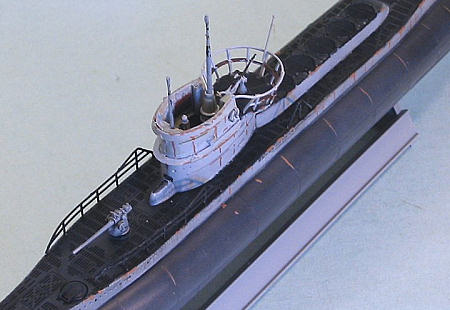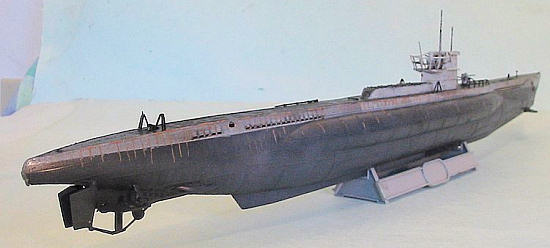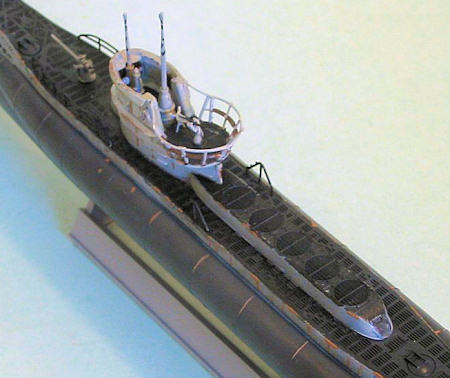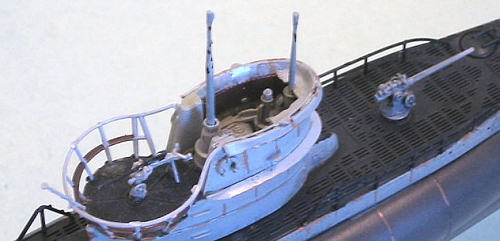
| KIT #: | ? |
| PRICE: | 12.76 Pounds Sterling |
| DECALS: | Six options |
| REVIEWER: | Tom Cleaver |
| NOTES: |

| HISTORY |
The Type VII U-boat first appeared as the VIIA in 1936. While it was not the best submarine in any particular aspect, it was the most successful submarine of the Second World War, forming the backbone of the U-boat force throughout the war.
The Type VII became the main craft of the U-boat force for two reasons. The
first was technical. The Type VII had the range, sea worthiness, armament, and
maneuverability to conduct an anti-shipping war in the North Atlantic.
Additionally, the Type VII was relatively cheap and could be built quickly using
mass-production techniques. Secondarily, naval policy influenced the
selection. Under the 1935 Anglo-German Naval Agreement, Germany was allowed to
construct submarines up to 35 percent the tonnage of
 the Royal Navy submarine
fleet, which was later increased to 100 percent. The Type VII, as a
medium-tonnage boat, could be built in greater numbers under these restrictions.
the Royal Navy submarine
fleet, which was later increased to 100 percent. The Type VII, as a
medium-tonnage boat, could be built in greater numbers under these restrictions.
709 Type VII U-boats of all variants were built during the war, more than any other submarine type built by any other nation. The U-boat appeared in seven main variants: VIIA, VIIB, VIIC, VIIC/41, VIIC/42, VIID and VIIF.
One of the most successful weapons in naval warfare was the mine. While the smaller U-boars could deliver mines through their torpedo tubes, only the XB U-boats, which were specifically designed as minelayers, could deliver the SMA cable anchored mines. The XBs were large and unwieldy, and could only be used as minelayers since their only other armament was two stern-mounted torpedo tubes. Because of this, only eight XBs were built and commissioned.
However, the SMA was the best type of mine, so the Oberkommando der Kriegsmarine directed that the Type VIIC U-boat be modified to enable it to deliver SMA mines while maintaining the full offensive capabilities of the Type VIIC. The result was the Type VIID, designed to lay SMA type mines in British coastal waters. Using the basic Type VIIC, a new hull section was inserted aft of the control room, containing five vertical mine launchers which could each carry three SMA mines, which increased overall length from 217 to 250 feet. The saddle tanks were also lengthened, which provided a larger load of diesel fuel, giving the Type VIID greater range than the Type VIIC. However, due to its increased size and weight, the Type VIID had marginally poorer maneuverability, and a slower top speed and diving time. Six Type VIIDs - U-213 to U-218 - were built by the Germania Shipyard in Kiel and commissioned between August 1941 and January 1942.
Of 31 patrols carried out by Type VIIDs between the Spring of 1942 and the end of the war, only nine were minelaying missions. On October 10, 1945, the British trawler “Kned” fell victim to a mine laid by U-218 on August 18,1944. The six Type VIIDs sank ten ships for a total 42,622 tons.
 After May 1943, the remaining Type VIIDs were stripped of their 88mm deck guns
and given a second flak platform over the first two mine silos. In 1945, U-218
was fitted with a snorkel.
After May 1943, the remaining Type VIIDs were stripped of their 88mm deck guns
and given a second flak platform over the first two mine silos. In 1945, U-218
was fitted with a snorkel.
U-213, which made 5 patrols and sank no ships, was sunk off the Azores on July 31,1942 by depth charges from HMS Erne, HMS Rochester and HMS Sandwich with loss of all hands. U-214 made 11 patrols and sank 3 ships before being sunk on July26, 1944 in the English Channel by HMS Cooke with loss of all hands. U-215 made one patrol, sinking one ship, before being sunk with all hands in the North Atlantic while on a minelaying operation. U-216 also made one patrol and sank one ship before being sunk on October 20 1942 by a Liberator off the southern coast of Ireland. U-217 made three patrols and sank three ships before being sunk in the North Atlantic on June 5, 1943, by Avengers from USS Bogue. U-218, the most successful of the class, made ten patrols between the summer of 1942 and the end of the war, sinking three ships. The U-boat sailed into Bergen, Norway, to surrender on May 8, 1945, and was lost in the North Sea while under tow by HMS Southdown during “Operation Deadlight” on December 4, 1945.
| THE KIT |
 For
those who do not have 4 cubic linear feet of storage space to display a Revell
1/72 scale U-boat, this 1/144 Type VIID is a good substitute. The kit has
excellent surface detail and looks like it was pantographed down from the larger
model. The raised rivet and weld line detail looks very effective, while the
deck is slatted correctly and the drain holes are deep enough to look accurate.
The kit is relatively simple, with a total of 93 parts on three dark grey sprues.
At an overall length of approximately 21 and a half inches, the kit is large
enough to provide good detail, without requiring a modeler add a new room to
their house for display.
For
those who do not have 4 cubic linear feet of storage space to display a Revell
1/72 scale U-boat, this 1/144 Type VIID is a good substitute. The kit has
excellent surface detail and looks like it was pantographed down from the larger
model. The raised rivet and weld line detail looks very effective, while the
deck is slatted correctly and the drain holes are deep enough to look accurate.
The kit is relatively simple, with a total of 93 parts on three dark grey sprues.
At an overall length of approximately 21 and a half inches, the kit is large
enough to provide good detail, without requiring a modeler add a new room to
their house for display.
The instructions are very complete, providing alternative paint schemes and markings for each of the Type VIID U-boats of the class at various points in their careers.
| CONSTRUCTION |
 I
haven’t built a ship model in over 40 years. A submarine is a good place to
begin for someone returning to ship modeling, or just starting out, due to their
basic simplicity. During construction of this kit, the only difficulty I
experienced was cutting off various of the smaller parts from the sprue without
damaging them. Some are small enough that damage is apparently inevitable, so I
spent some time glueing these back together. Even with all this, assembly of the
hull took less than two hours.
I
haven’t built a ship model in over 40 years. A submarine is a good place to
begin for someone returning to ship modeling, or just starting out, due to their
basic simplicity. During construction of this kit, the only difficulty I
experienced was cutting off various of the smaller parts from the sprue without
damaging them. Some are small enough that damage is apparently inevitable, so I
spent some time glueing these back together. Even with all this, assembly of the
hull took less than two hours.
| COLORS & MARKINGS |
 I
had decided to model U-218, so I then painted the hull, using Tamiya “NATO
Black” for the decks and Tamiya Panzer Grey for the lower hull. The sides of the
casing were painted with Xtracrylix “Light Compass Grey” and “Light Blue-Grey”
aircraft colors, in accordance with the instructions to portray the U-boat as it
appeared when serving with the 9th U-Flotille at Brest in the summer
and fall of 1942 . The conning tower parts were painted before assembly with
“Light Compass Grey,” with “Schockolade Braun” for the interior of the bridge.
I
had decided to model U-218, so I then painted the hull, using Tamiya “NATO
Black” for the decks and Tamiya Panzer Grey for the lower hull. The sides of the
casing were painted with Xtracrylix “Light Compass Grey” and “Light Blue-Grey”
aircraft colors, in accordance with the instructions to portray the U-boat as it
appeared when serving with the 9th U-Flotille at Brest in the summer
and fall of 1942 . The conning tower parts were painted before assembly with
“Light Compass Grey,” with “Schockolade Braun” for the interior of the bridge.
Once everything was dry, I gave the hull and the conning tower parts a light coat of Tamiya “Smoke”, which popped out the detail nicely and left the model with a “used” look. I then applied rust streaks with reddish-brown paint.
Once all this was dry, I assembled the conning tower in accordance with the instructions to portray U-218.
When everything was assembled, the model was given an overall coat of Xtracrylix Flat Varnish.
I was going to finish off by making the running wires from nylon thread, but discovered the thread had been recently turned into a cat toy, so that final part of the project awaits another day.
| CONCLUSIONS |
 I’ve always liked submarines, particularly those of World War II. I think 1/144
is the perfect for submarine models, being large enough to allow provision of
good detail, without being so big as to create storage and display problems once
finished. A modeler who knew what they were doing could “reverse engineer” this
kit to create a Type VIIC/41 U-boat with a minimum of effort, though I
personally hope Revell will release a Type VIIC on its own. The model will look
very good displayed with other 1/144 submarine models, particularly the new
Trumpeter Gato-class U.S. fleet boats. While the kit looks good assembled out
of the box, aftermarket sets for the railings would result in an outstanding
model.
I’ve always liked submarines, particularly those of World War II. I think 1/144
is the perfect for submarine models, being large enough to allow provision of
good detail, without being so big as to create storage and display problems once
finished. A modeler who knew what they were doing could “reverse engineer” this
kit to create a Type VIIC/41 U-boat with a minimum of effort, though I
personally hope Revell will release a Type VIIC on its own. The model will look
very good displayed with other 1/144 submarine models, particularly the new
Trumpeter Gato-class U.S. fleet boats. While the kit looks good assembled out
of the box, aftermarket sets for the railings would result in an outstanding
model.
August 2006
Copyright ModelingMadness.com
Review kit courtesy of www.hannants.co.uk
If you would like your product reviewed fairly and fairly quickly, please contact the editor or see other details in the Note to Contributors.